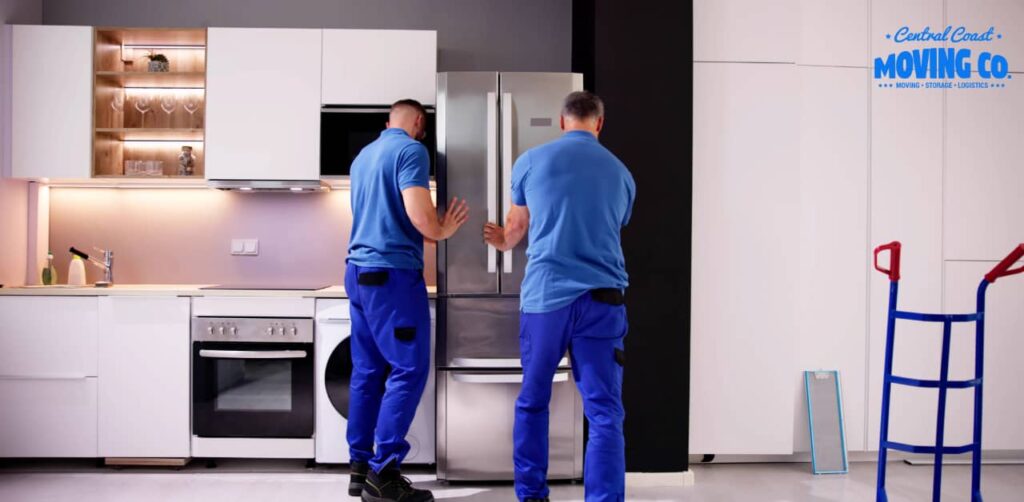

Moving a fridge or freezer is a task that requires careful planning and execution. These appliances are not only heavy but also contain delicate internal components that can be easily damaged if not handled correctly.
At Central Coast Moving Co, we’re experts in how to move a fridge and appliances, and we’re here to share our knowledge to help you move your fridge safely and efficiently and to answer common questions such as “Can you transport a fridge laying down?”
Transporting a fridge during a move is a task that demands special attention due to several factors. Firstly, their bulky size and heavy weight make them challenging to maneuver, especially through narrow doorways, tight corners, or up and down staircases.
This bulkiness requires not just physical strength but also strategic planning to navigate through various spaces safely.
The internal workings of these appliances contribute to their moving complexity. Fridges and freezers house sensitive components like compressors, cooling coils, and electrical parts.
These elements are crucial for the appliance’s functionality and are prone to damage and mishandling can lead to costly repairs or permanent damage.
It’s important for the safety of your fridge move that the correct preparations on done. Let’s take a look at the initial preparations:
Successfully moving a fridge is a task that requires the right equipment and techniques. It’s not just about brute strength; it’s about understanding the appliance’s structure and handling it in a way that ensures its safe arrival at your new home.
Here’s a detailed look at the safest and easiest way to move a fridge:
This phase is as important as the move itself, as improper handling post-move can lead to potential issues. Here’s our recommendation on how to set up your fridge after the move:
In conclusion, moving a fridge safely is indeed a complex and nuanced task that demands attention to detail, careful planning, and a methodical approach. By adhering to the steps and guidelines outlined in this guide, you can significantly reduce the risk of damage to your fridge during the moving process.
It’s about understanding the unique challenges that come with transporting such a large and delicate appliance and taking the necessary steps to address them.
At Central Coast Moving Co, we specialize in moving large appliances like fridges and freezers.
Our team of professionals is equipped with the right tools and expertise to handle your fridge move efficiently and safely.
We understand the nuances of appliance moving and are committed to ensuring your fridge arrives at your new home in perfect condition. With us, you can expect:
For any inquiries or to discuss the specifics of your fridge move, feel free to reach out to us at +1 (805) 441-4429. You can also get an instant price estimate through our website, making your planning process even more convenient.
Read our most frequently asked questions on how to move a fridge safely:
While it’s always preferable to move fridges in an upright position to protect their internal components, there are situations where laying them down is unavoidable. If you need to lay your fridge down, ensure it’s well-padded to protect it from jostles and bumps and secure it to prevent any shifts during transport.
If your fridge was kept upright during the move, you can safely turn it on immediately upon arrival. If it was transported lying down, it’s crucial to let it stand upright for a few hours before powering it up. This allows the internal fluids to settle back into their proper places, ensuring the cooling system functions correctly.
Moving a fridge can potentially cause damage if not done correctly. It’s essential to handle the fridge with care, using appropriate equipment and techniques. Ensure the fridge is securely fastened during transport and avoid excessive tilting or shaking, which can disturb the internal mechanisms.
Plugging in a fridge too soon after it has been laid down can lead to damage to the cooling system. The refrigerant needs time to settle back into the compressor. Waiting a few hours before plugging it in helps prevent any potential damage and ensures the fridge resumes normal operation.
Central Coast Moving your Trusted Partner for Stress-Free Moves. Specializing in residential and commercial relocations, we offer comprehensive moving services in Paso Robles and beyond.
Experience seamless transitions with our expert packing, on-site moving, and secure storage solutions. Dedicated to excellence, our team provides peace of mind with professional handling and reliable service seven days a week.
Contact us for a personalized moving experience that sets new standards in customer care.
The contents of this website, including but not limited to all text, graphics, images, and designs, are the exclusive property of Central Coast Moving Co. The intellectual property laws of the United States and the State of California protect them. The website design, including all its contents, such as text, graphics, logos, and images, is the exclusive property of Central Coast Moving Co. It is protected under copyright and other intellectual property laws. No part of this website may be copied, reproduced, republished, uploaded, posted, transmitted, distributed, decompiled, reverse-engineered, or used in any manner or for any purpose without the express written consent of Central Coast Moving Co.